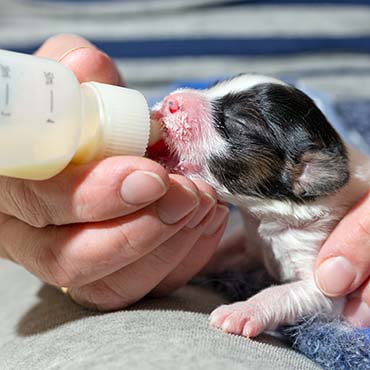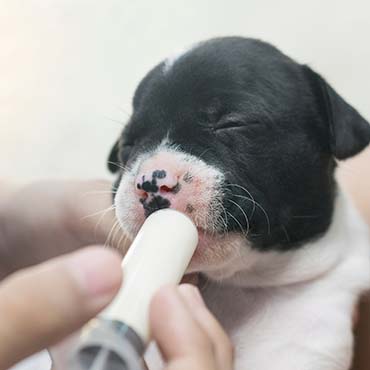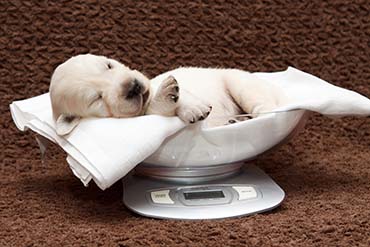Hand rearing puppies
Overview
- Hand rearing puppies can be very rewarding, but is a big commitment.
- Hand rearing involves keeping your puppies warm, regular feeding, toileting, cleaning, health monitoring and socialisation.
- Always contact your veterinary practice for advice before hand rearing a litter of puppies.
- Contact your vet straight away if you notice that your puppies aren’t thriving, or you’re worried about their health.
Newborn puppy care
Hand rearing can be a very rewarding process but there is no getting around the fact that it’s hard work. Before taking on the responsibility, it’s important you consider exactly what is required and whether you’ll be able to do it. Always speak to your veterinary practice for advice.
This article covers:
- Warmth
- Feeding
- Toileting
- Cleaning
- Weighing
- Problems and FAQ’s.

Hand rearing puppies takes a lot of hard work
Warmth
Puppies can’t regulate their own body temperature, and without a mother they are likely to get cold. They need to be in a warm environment, ideally between 29˚ and 32˚C for the first week, and gradually adjusted to room temperature by week 6. Keep your puppies warm with a cosy bed, heat pads or a heat lamp. If using heat pads, make sure there’s plenty of padding between them and the pad to prevent burns. If using a heat lamp, make sure it’s the right distance away from them (follow the safety guidelines carefully). By 6 weeks of age, your puppies can be kept at room temperature (21˚C), but be sure to adjust them slowly. It’s very important to give your puppies an area that’s big enough for them to move away from the heat if they need to.
Feeding a newborn puppy
What to feed
Newborn puppies need artificial milk formula specifically for puppies, this is available from most vets and reputable pet shops. Kitten/puppy milk from the supermarket is not suitable. Cow’s milk is also unsuitable.
Things you’ll need
- Artificial milk formula specifically for puppies (available from vets or good pet shops)
- A puppy feeding kit (available from vets or good pet shops) - human baby bottles aren’t suitable, they are too big and deliver too much milk.
- Sterilising tablets or solution (available from chemists)
- Cotton wool
- 2ml syringes
- Weighing scales.
When and how much
Your milk formula packaging will have an instruction chart, telling you how much and how regularly to feed. Up to seven days old, puppies normally feed every two hours, including through the night. After the first week, you can start gradually extending the time between milk feeds and at 4 weeks you can start introducing puppy food. At six weeks of age, your puppies should be fully weaned. See our rough guide bellow:
| Week 1 | Milk feed every 2 hours |
| Week 2 | Milk feed every 3 hours |
| Week 3 | Milk feed every 3 hours |
| Week 4 | Milk feed every 4-6 hours, offer a saucer of water and softened puppy food for lapping. |
| Week 5 | Wet puppy food, fresh water to drink. Milk down to lap and top up bottle feeds if necessary. |
| Week 6 | Fully weaned off milk, feed a complete puppy food and water. |
*always refer to formula milk instructions
Bottle preparation
It’s extremely important to make sure your feeding bottles stay clean, hand reared puppies don’t receive normal antibody protection from their mother’s milk, which makes them vulnerable to getting ill.
Wash all bottles and teats after each feed using warm soapy water and a bottlebrush, Rinse them well afterwards. After washing the bottles, sterilise them using a sterilising solution or tablet from any chemist. Leave them in the sterilising solution for the correct time and flick off any excess solution before feeding your puppies.
Milk preparation
Artificial milk formula usually comes as a powder that needs mixing with warm water.
- Wash your hands.
- Clean your preparation surface.
- Boil some fresh water.
- Using a thermometer, allow the water to cool to the correct temperature (find this in the formula milk instructions). The correct temperature allows the milk powder to dissolve properly with no clumps.
- Carefully measure out the powder and the correct amount of water, using a measuring cup or scales. If you use a measuring cup, make sure you level the powder with the flat edge of a knife to ensure you don’t put too much in.
- Once the milk is prepared, test it on the underside of your wrist to make sure that it’s a comfortable temperature for your puppies.
Bottle feeding
A long as your puppies have a strong suck, they can be bottle-fed.
- Hold or put your puppy in a natural feeding position, as if they were feeding from their mother. The natural feeding position for a puppy is on their belly. Feeding a puppy on its back could cause them to breath in the milk.
- Present the bottle teat to them and allow them to suck.
- Give them regular breaks if they try to detach, otherwise let them suck until them seem full.
- If you see any bubbles of milk coming out of your puppy’s nose, stop feeding and wipe them clean. This usually indicates that the milk has gone down into the lungs or up into their nose. Wait to make sure they are breathing OK before trying again, a bit slower and in the correct feeding position.
Top tip: Make sure that there are holes in the end of the bottle teats (some come without!). If the teat you are using has no holes, use a pin to prick a few into the end of it. Milk should come out comfortably with a light suck, if the holes are too small your puppy may swallow air instead of milk, if they are too big the milk may come out too quickly.
Syringe feeding
If your puppy is struggling to feed from a bottle, you may need to feed them with a syringe until they are strong enough to suck. Syringe feeding needs to be done very carefully because your puppy has no control over how much milk they get.
- Hold your puppy in the position that they would be in if they were feeding from their mother.
- Drip small amounts of milk onto their tongue and let them swallow it.
- If necessary, encourage your puppy to swallow by gently massaging their throat.
- Be very careful not to force milk into your puppy because they may choke.

Syringe feeding may be necessary if a puppy is struggling to feed from a bottle
Helping your puppies go to the toilet
Your puppies will need help weeing and pooing until they are approximately three weeks old. Normally, their mother would lick them to stimulate them to go to the toilet, so you will need to replicate this, using damp cotton wool, after each feed.
- Use warm, damp cotton wool to gently wipe their bottom and vulva or penis areas in the same way that their mother might lick them.
- Continue until you see them pass urine and/or faeces.
- Wipe them clean afterwards, using fresh, clean cotton wool and warm water.
Cleaning your puppies
It’s important to keep hand-reared puppies clean because they aren’t receiving antibodies from their mother’s milk and will be slightly more vulnerable to infections. Wipe away any spilt milk after feeds and ensure they are clean after toileting. Clean their bedding and living area daily.
Weighing your puppies
From day one, make sure you can identify each puppy individually. Make a record of their birth weight, and weigh them every day thereafter (at approximately the same time). Your puppies should gain weight every day, contact your vet for advice if any of your puppies lose weight or aren’t keeping up with the others.

Weigh your puppies daily
Hand rearing problems/when to contact your vet
Hand reared puppies are vulnerable to infections when they are young, because they don’t receive natural antibodies from their mother’s milk. They are also prone to constipation and tummy upsets. Contact your vet for advice if you notice anything wrong with your puppies, if they don’t seem quite right, or you suspect a problem.
- How long should I continue to feed my puppies every 2 hours?
- My newborn puppy seems constipated, what can I do?
- How long can newborn puppies go without eating?
- At what age can my puppies go to their new home?
- When can my hand-reared puppies be vaccinated?
How long should I continue to feed my puppies every 2 hours?
For detailed information, follow the guidelines on the back of your puppies’ formula milk packet. Please see our rough guide above.
My newborn puppy seems constipated, what can I do?
Contact your vet for advice if your puppy isn’t pooing normally; constipation can be very dangerous and painful. Your vet may prescribe stool softeners or administer an enema to help your puppy poo. If you catch this problem early enough though, they may advise replacing their next feed with cooled boiled water (no milk). A water meal is fine as a one-off and can help loosen constipation. The constipation should resolve after treatment, at which point you can continue feeding milk. Constipation in artificially fed puppies is often caused by clumps in their formula milk (that are difficult to digest). Clumps develop when formula powder is mixed with water that is too hot, or too cold. Make sure that you follow your milk preparation instructions carefully to prevent problems.
How long can newborn puppies go without eating?
Newborn puppies need to be fed every two hours through day night for the first three weeks of their life. Feed frequency can then be slowly reduced until they are fully weaned at 6-7 weeks old. Contact your vet if any of your pups aren’t feeding properly.
At what age can my puppies go to their new home?
Even though your puppies aren’t leaving their mum, they still need to be eight weeks old before they go to their new home.
When can my hand-reared puppies be vaccinated?
Your puppies may be vulnerable to disease because they haven’t received antibodies from their mother’s milk. Because of this, your vet may advise to start your puppies’ primary vaccination course from six weeks of age. First vaccines are also a great opportunity to have a full health check from your vet.
Published: September 2019
Did you find this page useful?
Tell us more
Please note, our vets and nurses are unable to respond to questions via this form. If you are concerned about your pet’s health, please contact your vet directly.
Thank you for your feedback
Want to hear more about PDSA and get pet care tips from our vet experts?
Sign up to our e-newsletter
Written by vets and vet nurses. This advice is for UK pets only. Illustrations by Samantha Elmhurst.

